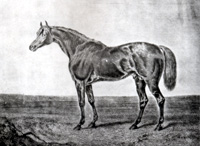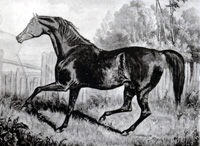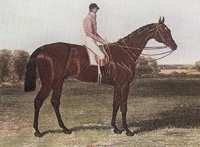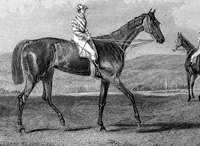|

Courtesy of Fores Gallery



Sire Line

Whalebone

Waxy

Pot8os


Coronation, by Sir Hercules, courtesy of
Fores Gallery

Cruiskeen, by Sir Hercules

Gemma-di-Vergy, by Sir Hercules
 |
Sir Hercules bl c 1826 (Whalebone
- Peri, by Wanderer). Sire Line Pot8os.
Family 2-t. Sir Hercules was bred by Mr Lang
in the north of Ireland and was the first foal of his dam Peri (b f 1822 Wanderer). Peri was
bred by Lord Egremont and sold to Mr Lang who bred her to Whalebone and
sent her to Ireland. Both Sir Hercules and Peri were sold to Lord Langford
(1795-1839), 2nd Baron Langford, in 1828 although Peri
returned to England several times to visit English stallions
before her death in 1847. Sir Hercules was a half brother to Langford (br c
1833 Starch) who was a stallion in America.
Undefeated as a two-year old in Ireland,
he went to England as a
three-year old where he won the Claret Stakes and finished third for the
Great St Leger Stakes at Doncaster. There was some feeling that
he was tampered with before the St Leger and his jockey,
Connolly, was said to have expressed grief over the manner in
which Sir Hercules was treated. It was taken as a measure of his
gameness that he finished so well as he did.
He retired first to the Langford stud at Summer Hill in
County Meath, Ireland, but in 1833 at the sale of Lord
Langford's stud at Doncaster he was sold to "an American
gentleman" for 750 guineas by Richard Tattersall. Apparently
there was concern over sending him across the pond so late in
the season and he was resold to Mr Weatherby
and relocated to Dawley Wall, a stud farm near Uxbridge belonging to Mr Tattersall.
He was then shuffled through numerous studs, few of which appear
to have been to his benefit. The next two years were spent at East Acton. He was subsequently
leased to Mr Stovin who had him at Small Heath, near Birmingham
for the season of 1837, however he returned to East Acton, near London,
where he remained until his owner died. Sir Hercules was then
sold to the Right Hon Sidney Herbert (later Lord Lea) who sent
him to Wilton, near Salisbury, and was said to have restricted
access to only his own mares. When Mr Herbert sold his stud Sir
Hercules was acquired by Mr Phillips, who found his new horse at a livery
stable in London and in very poor condition. Once Sir Hercules
arrived at Bushbury he was said to have been treated with the greatest care and
to have recovered his vitality.
He
was noted for the silver hairs on his flanks and quarters and at the
root of his tail, which he often passed on to his descendants. The
'bonny black" was described as a "round-made horse, in which
shape he was followed by his son Birdcatcher, though not by his
two other famous sons Coronation and Faugh-a-Ballagh, both of
whom were larger and more lengthy than their sire". He stood
close to fifteen hands two inches and was said to be rather
a close-knit horse, of excellent substance, with room for no
more than a saddle on his back.
Without doubt his best son was Birdcatcher
(ch c 1833) through whom the Eclipse
Sire Line to
Phalaris (br
c 1913 Polymelus) was perpetuated. Sir
Hercules died in 1855.
| Sir
Hercules |
Whalebone |
Waxy |
Pot8os |
| Maria |
| Peneleope |
Trumpator |
| Prunella |
| Peri |
Wanderer |
Gohanna |
| Catherine |
| Thalestris |
Alexander |
| Rival |
|
| Race Record |
| |
| In 1829 he won a
20 sovs each sweepstakes at the York Spring Meeting,
beating Mr Petre's Netherby (b c 1826 Cervantes), Mr
Healey's Flambeau (b c 1826 Grey Malton), Mr Kirby's Flacrow (b c 1826
Blacklock),
Lord Kelburne's Viscount colt, and Mr Bailey's Brielle.
Finished 3rd for the Great St Leger Stakes at Doncaster,
won by Mr Petre's Rowton (ch c 1826 Oiseau),
with Lord Cleveland's
Voltaire (br c 1826
Blacklock)
placing 2nd, beating Lord Worcester's Felt (b c 1826
Langar), Mr Ridsdale's Clotilde (b f 1826
Tramp), Mr Gratwicke's Frederick (b c 1826 Little John) and 13
others. Won a 30 sovs each sweepstakes at the same
meeting, beating Mr Houldsworth's Fortitude (ch f 1826
Whisker) and Mr Riddell's Zodiac (ch c 1826 The Grand Duke). |
| |
| In 1830 he won
the 200 sovs each Claret Stakes at Newmarket in April,
beating Lord Sefton's Morris-Dancer (b c 1826 Morisco ),
Lord Hunter's grey Gustavus colt and Lord G H
Cavendish's Spaniard (br c 1826 Godolphin). |
| |
| In 1831 he went unplaced for the Stand Cup at
Liverpool, won by Mr Nowell's bay Walton
colt, with Mr Nanney's Penthos 2nd, and Mr
Clifton's Moss Rose 3rd; 3 others started. |
| |
| Notable
Offspring |
| |
Coronation (GB)
b c 1838 (Sir Hercules - Ruby, by
Rubens). Sire Line Pot8os.
Family 26. Bred by Abraham Rawlinson, at Chadlington, near
Chipping Norton, he was trained at home by Mr
Rawlinson's private groom Painton. He won the Derby Stakes
and the Ascot Derby. Standing 16 hands he was said to be
of good shape and very handsome with "capital open
feet". He was later sent to
Russia.
|
| |
Cruiskeen (IRE)
ch f 1834 (Sir Hercules - Brandy
Bet, by Canteen). Sire Line Pot8os.
Family 3. Bred by Lord Miltown,
she was the winner of a number of races including the Cesarewitch and the Chester Cup,
and later produced the stallion Russborough (ch c 1847 Tearaway).
|
| |
Gemma di Vergy (GB)
br c 1854 (Sir Hercules -
Snowdrop, by Heron). Sire Line Pot8os.
Family 20. Bred by Mr Bond, sold to
Mr T Walker for 225 guineas in 1856, he won the Fernhill Stakes,
the Reading
Stakes, the Avon Stakes, the Nursery Handicap, the Whittlebury Stakes and
the Racing
Stakes. He was later sent to Australia.
|
| |
Gunboat (GB)
br c 1854 (Sir Hercules - Yard Arm,
by Sheet Anchor). Sire Line Pot8os.
Family 1-d. A
full
brother to Lifeboat, he finished 2nd of 19 in the Goodwood
Stakes as a three year old and won eight races as a four
year old. Said to be very like his sire but on a "much
larger scale," standing 2 inches taller. He was later a
useful stallion.
|
| |
Hagley (GB)
ch c 1845 (Sir Hercules - Mare, by
Bobadil). Sire Line Pot8os.
Family 35. A winner of the Royal Hunt Cup.
|
| |
Hartneitstein (GER)
b c 1846 (Sir Hercules - Lady
Ishmael, by Ishmael). Sire Line Pot8os.
Family 22. A
stallion in Germany.
|
| |
Knight of the
Shire (GB)
b c 1849 (Sir Hercules - Splitvote, by St
Luke). Sire Line Pot8os.
Family 2-u. A winner of Cambridgeshire
he was a half
brother to the good mare Bribery (ch f 1851 The Libel)
who produced the St Leger winner St Albans (ch c 1857
Stockwell), and a half
brother to Lady Mary (b f 1854
Orlando) who
bred the Two Thousand Guineas winner Gang Forward (ch c
1870 Stockwell).
|
| |
Lady Lift (GB)
b f 1844 (Sir Hercules - Sylph, by
Spectre). Sire Line Pot8os.
Family 35. A winner of Poule d'Essai des Poulains, Prix
du Jockey Club, she was the dam of the French stallions Le Marechal
(b c 1860 Monarque) and Consul (b c 1866 Monarque).
|
| |
Lifeboat (GB)
br c 1855 (Sir Hercules - Yard Arm,
by Sheet Anchor). Sire Line Pot8os.
Family 1-d. A
full brother to Gunboat, he won fifteen races and was said to
take "a good deal after his dam" and possess "grand
shoulders, back, loins and thighs". He was later a
stallion.
|
| |
The Corsair (GB)
bl c 1836 (Sir Hercules -
Gulnare, by Smolensko). Sire Line Pot8os.
Family 4-l. Bred by the 5th Duke of Richmond
from the Oaks winner Gulnare, he won the Two Thousand Guineas Stakes.
|
| |
Vibration (GB)
b f 1839 (Sir Hercules - Echo, by
Emilius).
Sire Line Pot8os.
Family 22-b. A winner of Ascot Stakes, and
ancestress of numberless good winners, notably the Two
Thousand Guineas winner St Frusquin (br c 1893
St Simon) and the Phoenix
Stakes winner Danehill Dancer (b c 1993 Danehill). Many
of her descendants are successful runners from Australia
and New Zealand. |
|

